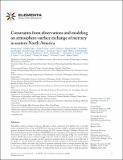Constraints from observations and modeling on atmosphere–surface exchange of mercury in eastern North America
Author(s)
Gratz, Lynne E.; Ambrose, Jesse L.; Jaffe, Daniel A.; Shah, Viral; Jaeglé, Lyatt; Giang, Amanda; Yuan, Bin; Kaser, Lisa; Apel, Eric C.; Hornbrook, Rebecca S.; Blake, Nicola J.; Weinheimer, Andrew J.; Mauldin III, Roy L.; Cantrell, Christopher A.; Castro, Mark S.; Conley, Gary; Holsen, Thomas M.; Luke, Winston T.; Talbot, Robert; Song, Shaojie; Selin, Noelle E; ... Show more Show less
DownloadSelin_Constraints from.pdf (1.531Mb)
PUBLISHER_CC
Publisher with Creative Commons License
Creative Commons Attribution
Terms of use
Metadata
Show full item recordAbstract
Atmosphere–surface exchange of mercury, although a critical component of its global cycle, is currently poorly constrained. Here we use the GEOS-Chem chemical transport model to interpret atmospheric Hg⁰(gaseous elemental mercury) data collected during the 2013 summer Nitrogen, Oxidants, Mercury and Aerosol Distributions, Sources and Sinks (NOMADSS) aircraft campaign as well as ground- and ship-based observations in terms of their constraints on the atmosphere–surface exchange of Hg⁰ over eastern North America. Model–observation comparison suggests that the Northwest Atlantic may be a net source of Hg⁰, with high evasion fluxes in summer (our best sensitivity simulation shows an average oceanic Hg⁰ flux of 3.3 ng m⁻² h⁻¹ over the Northwest Atlantic), while the terrestrial ecosystem in the summer of the eastern United States is likely a net sink of Hg⁰ (our best sensitivity simulation shows an average terrestrial Hg⁰ flux of -0.6 ng m⁻² h⁻¹ over the eastern United States). The inferred high Hg⁰ fluxes from the Northwest Atlantic may result from high wet deposition fluxes of oxidized Hg, which are in turn related to high precipitation rates in this region. We also find that increasing simulated terrestrial fluxes of Hg⁰ in spring compared to other seasons can better reproduce observed seasonal variability of Hg⁰ concentration at ground-based sites in eastern North America.
Date issued
2016-04Department
Massachusetts Institute of Technology. Department of Earth, Atmospheric, and Planetary Sciences; Massachusetts Institute of Technology. Institute for Data, Systems, and SocietyJournal
Elementa: Science of the Anthropocene
Publisher
University of California Press
Citation
Song, Shaojie, Noelle E. Selin, Lynne E. Gratz, Jesse L. Ambrose, Daniel A. Jaffe, Viral Shah, Lyatt Jaeglé, et al. “Constraints from Observations and Modeling on Atmosphere–surface Exchange of Mercury in Eastern North America.” Elementa: Science of the Anthropocene 4 (April 8, 2016): 000100. © 2016 Song et al
Version: Final published version
ISSN
2325-1026